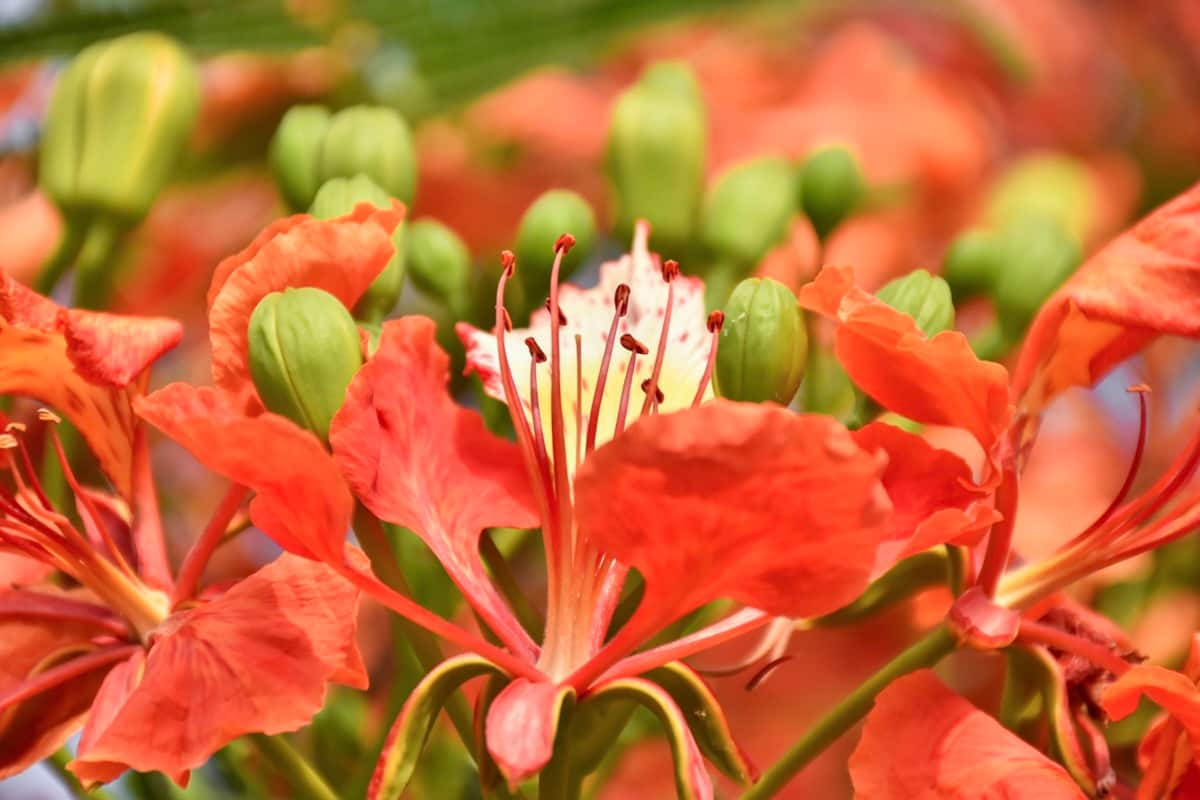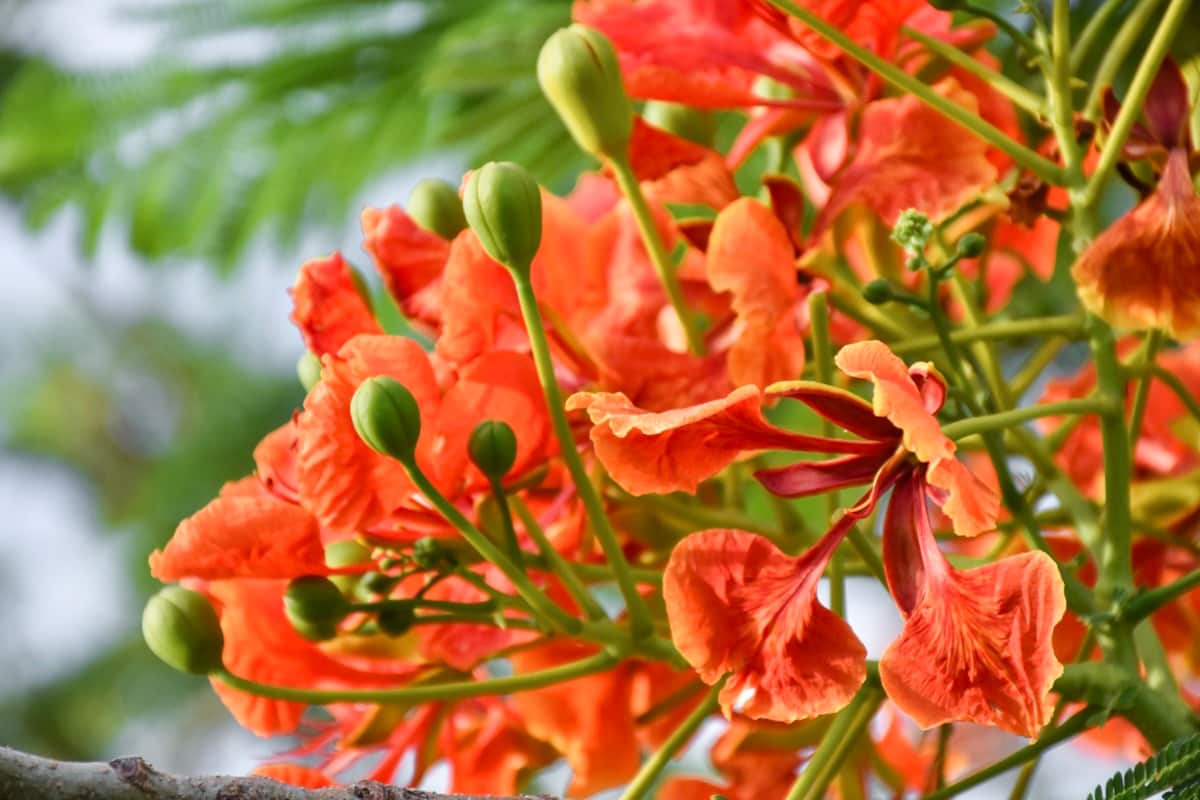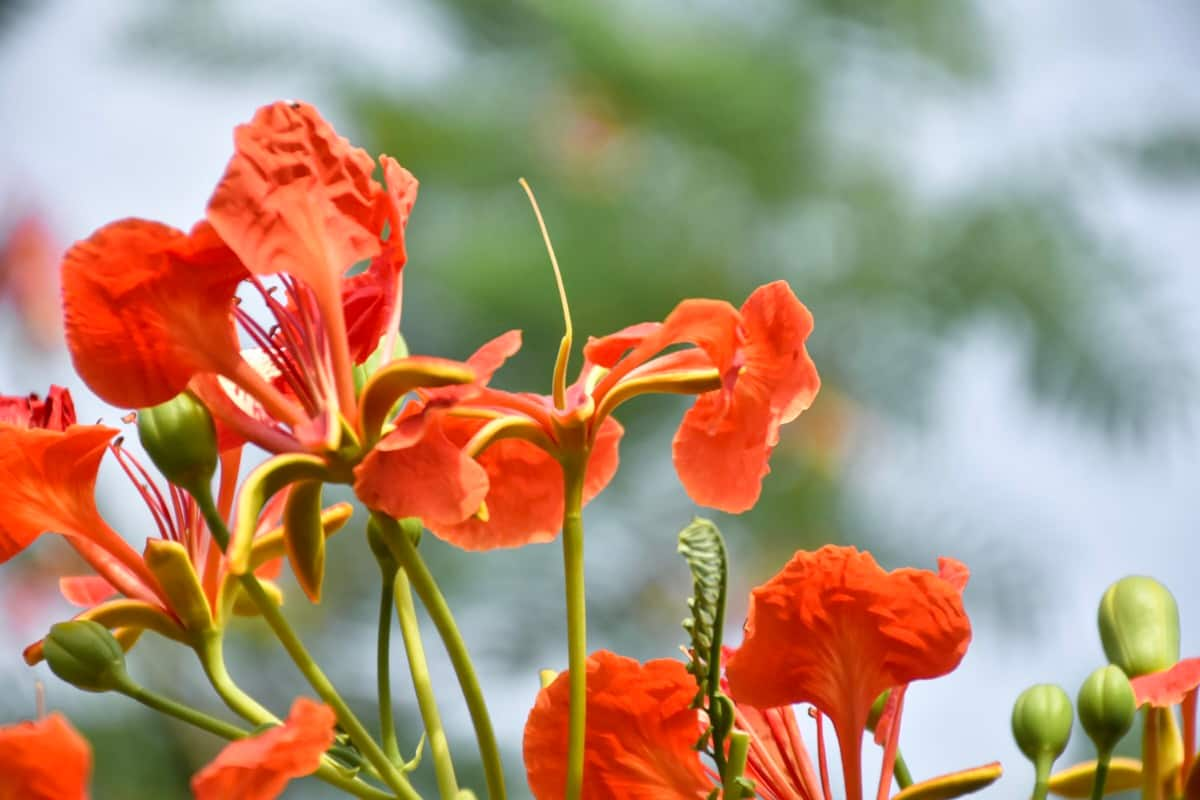The Royal Poinciana tree is a strikingly beautiful tropical tree known for its flamboyant display of flowers, with fiery red, orange, and yellow petals that burst into a blaze of color in the summertime. This large, spreading tree is a much-loved feature in warm-weather landscapes, particularly admired for its lush, feathery foliage and broad, umbrella-like canopy.

However, the tree’s unparalleled beauty comes with its share of Poinciana tree problems, including vulnerability to frost and pests, which we will explore in depth in this article. Here, we provide comprehensive information on how to grow and care for a Royal Poinciana tree, from propagation methods such as Royal Poinciana seed germination to insights into the Royal Poinciana root system, watering requirements, and much more.
How to Grow and Care for Royal Poinciana
Ideal Growing Conditions for Royal Poinciana Tree
Royal Poinciana trees thrive in full sun and well-drained soil. Although they are drought-tolerant, they prefer regular watering for optimal growth. It’s also critical to ensure they have plenty of space to grow, as the canopy can spread up to 60 feet wide, and their extensive root system can disrupt nearby structures. They are highly adaptive to various soil types but prefer acidic to slightly alkaline conditions.
Moreover, they can withstand salty conditions, making them ideal for coastal areas. These fast-growing trees can achieve an impressive 30 to 40 feet height within a few years. This rapid growth rate addresses the frequently asked question of how fast Royal Poinciana trees grow. Royal Poinciana trees also make great Royal Poinciana bonsai, provided they are meticulously cared for and pruned regularly to maintain the desired size and shape.
Step-by-step Guide to Planting Royal Poinciana Seeds
To grow a Royal Poinciana tree from seeds, start with the Royal Poinciana seed germination process. To ensure successful germination, the hard outer shell of the seeds must be softened. This can be achieved by either soaking the seeds in warm water for at least 24 hours or making small cuts in the shell using a knife. After this preparation, plant the seeds approximately 1 inch deep in a container filled with well-draining potting soil.
Clean the soil thoroughly and place the container in a warm and well-lit area. It is important to maintain proper soil moisture and warmth. Within a few weeks, you should observe the initial signs of growth. When the young plants grow a few inches tall and sprout a couple of true leaves, you can move them to a bigger pot or plant them in the desired location.
Watering Requirements for Royal Poinciana Tree
While Royal Poinciana trees are drought-tolerant, they appreciate regular watering for optimal growth. The ideal watering regimen varies depending on the tree’s age, size, and prevailing climate conditions. Young trees need frequent watering until they become established. Once established, the trees can survive on less water, but watering them regularly, especially during dry spells, will enhance their growth and flowering. To prevent root rot, it is important to avoid excessive watering. The recommended approach is to water deeply but not too often. It is crucial to allow the soil to dry out between watering sessions.
Pruning Tips for Maintaining a Healthy Royal Poinciana Tree
Pruning is crucial to maintaining a healthy Royal Poinciana tree. Regular pruning helps to maintain the tree’s shape, promote strong branch growth, and enhance flowering. It also aids in the creation of a Royal Poinciana bonsai. Pruning is best carried out for optimal results during late winter or early spring before the onset of new growth. Begin by eliminating any dead, diseased, or injured branches.
Additionally, trim branches that intersect or rub against each other to prevent harm to the tree. Ensuring the tree’s structural integrity does not have two leading central branches is important. If this occurs, select the strongest and healthiest of the two and remove the other. Moreover, to ensure safety and prevent property damage, remove branches that hang too low or too close to buildings.
In case you missed it: How to Grow and Care for Red Valerian: Planting Instructions

Fertilizer Recommendations for Royal Poinciana Tree
The Royal Poinciana is not particularly demanding regarding fertilizer but appreciates a nutritional boost, especially during the growing season. Use a 10-10-10 (NPK) formula fertilizer twice a year, in spring and summer, for ideal growth and blooming. In addition, you may consider supplementing with a high-phosphorus fertilizer to enhance flowering. It is also beneficial to provide micronutrients, such as iron and magnesium, which can sometimes be deficient in the soil. Always follow the manufacturer’s instructions for the correct dosage when applying fertilizers.
Protecting Royal Poinciana From Pests and Diseases
Royal Poinciana trees are susceptible to certain pests and diseases despite their hardiness. Common Poinciana tree problems include fungal diseases such as root rot and verticillium wilt, which can be prevented by avoiding overwatering and ensuring proper soil drainage. Pests like scales, mealybugs, and caterpillars can also cause damage. Caterpillars, in particular, feed on the Royal Poinciana flower.
Regularly inspect the tree for signs of these pests and use an appropriate insecticide if necessary. A more significant concern is the Royal Poinciana caterpillar, which can cause severe defoliation. These pests should be removed manually, and the tree should be treated with a suitable biological insecticide.
Best Time to Transplant a Royal Poinciana Tree
Transplant the Royal Poinciana tree in late winter or early spring before new growth starts. This lets the tree adjust to its new spot and develop roots before the rapid growth of warmer months. Make the new hole twice the width and depth of the root ball. Plant the tree at the same depth as before. Fill the hole with the original soil and water well to settle the roots. Consider the extensive root system of the Royal Poinciana and choose a spacious spot, keeping in mind nearby structures.
Creating a Supportive Structure for Royal Poinciana Tree Growth
Given the Royal Poinciana tree’s impressive size and sprawling canopy, it’s crucial to provide a supportive structure for the tree, especially during its early years. Staking the tree helps it grow straight and prevents the trunk from bending or snapping under the weight of the canopy. When planting, place the stake in the ground, ensuring it is sturdy enough to support the tree. Secure the tree to the stake with a soft, flexible material to prevent damage to the trunk.
As the tree grows, you may need to adjust the stake and the ties to accommodate the expanding trunk diameter. Moreover, the Royal Poinciana root system is far-reaching and can extend up to two times the radius of the canopy. These lateral roots stabilize the tree but can potentially disrupt nearby structures. Therefore, ensure that the tree is planted at an adequate distance from buildings, walls, and underground utilities to avoid any conflicts.
In case you missed it: How to Grow and Care for Red Trumpet Creeper: Planting Instructions

Conclusion
Growing a Royal Poinciana tree can be a gratifying experience, given its spectacular display of flowers and its magnificent size. While the tree requires some care and attention to manage common Poinciana tree problems, the results are well worth the effort. This detailed guide lets you cultivate and enjoy the Royal Poinciana tree in your landscape.
- Ultimate Guide to Ossabaw Island Hog: Breeding, Raising, Diet, and Care
- Ultimate Guide to Juliana Pig: Raising Facts, Size, Diet, Care, and Lifespan
- Raising Lleyn Sheep: Disadvantages, Price, Uses, Characteristics, and Care
- Ultimate Guide to Meishan Pig: Breed Facts, Breeding, Raising, and Care
- Ultimate Guide to Teacup Pigs: Raising, Diet, Lifespan, Cost, and Care
- Guide to Raising Poll Dorset Sheep: Facts, Profile, Characteristics, Uses, and Care
- Ultimate Guide to Bighorn Sheep: Characteristics, Diet, Lifespan, Breeding, and Lifecycle
- Ultimate Guide to Raising Katahdin Sheep: Farming Facts, Breed Profile, Uses, and Care
- Ultimate Guide to Raising Oreo Cows: Belted Galloways Farming Facts, Profile, Uses, and Care